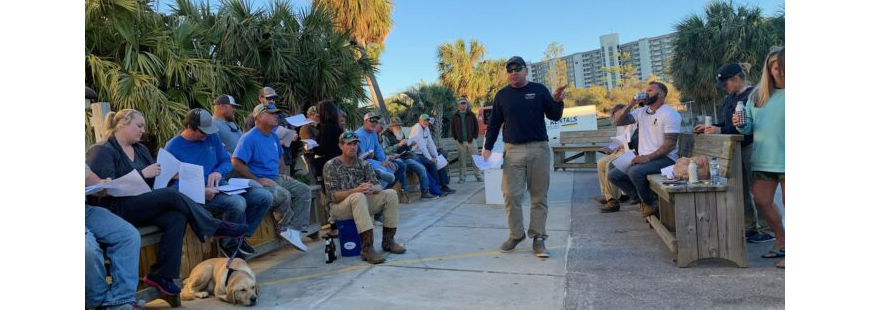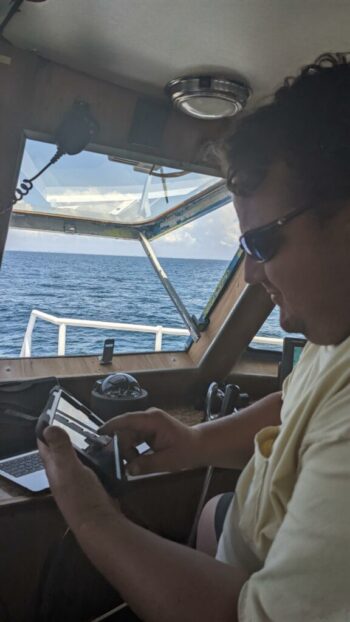This article first appeared on EM4Fish and is reprinted with permission. Top photo: Port Ambassador meets with a group of local charter for-hire captains to walk through the ELB program and system requirements. Photo Credit: Bobby Kelly
Industry Takes Initiative to Improve Data Collection and their Fishery
The Port Ambassador program is a peer-to-peer industry-led communications partnership that has helped smooth the implementation of the Gulf of Mexico Electronic Logbook (ELB) program and can serve as a model for other regions and programs. The ELB program addresses a longstanding problem in monitoring. For nearly two decades, federally permitted charter for-hire captains raised concerns to the Gulf of Mexico Fishery Management Council (Gulf Council), NOAA Fisheries and even Congress about the lack of data in their fishery and the need for improvements. A lot of fishermen realized that there was a large uncertainty in the for-hire data, and that data uncertainty creates management uncertainty, and at the end of the day, that meant we were leaving fish on the table. The industry began a dialogue to bring more sophistication to data collection and monitoring, specifically advocating for an electronic logbook program. As a result, Charter Fisherman’s Association (CFA), the largest for-hire fishermen’s association in the Gulf, created the Port Ambassador Program to help smooth the transition to electronic reporting (ER). Our industry worked with the agency to design, implement, and communicate the rollout of a newly implemented electronic reporting program, and we will continue to push for more inclusion of appropriate technology and robust data.
Trusted Leaders
As leaders in the for-hire industry, we have supported the development of the Southeast Electronic For-Hire Reporting (SEFHIER) Program, an electronic logbook reporting program, and want to see our data used to support management before the SEFHIER Program was officially implemented in 2020, we heard complaints and resistance among some fishermen against government data collection. The SEFHIER program involves collecting data electronically from captains using technologies which are tried and true for many commercial programs, however, are novel to the recreational sector and were not yet familiar to many in our industry. We understood that we have a voice to share in guiding our industry and that NOAA Fisheries cannot communicate in the same ways that we can. The solution was the Port Ambassador program – a peer-to-peer initiative for information sharing.
Acknowledging that there is a learning curve to using new technologies, the Port Ambassadors serve as a two-way communication source between NOAA Fisheries and the industry. NOAA Fisheries doesn’t have the same communication opportunities as the industry, since we can use our local networks and social media channels to speak directly to each other. The Agency’s own research indicates that by a wide margin, fishermen trust fishermen when it comes to news and information about their fisheries – this is the whole premise of the Port Ambassador program.
The Port Ambassadors began to host outreach meetings in January 2021 and established themselves as trusted knowledge brokers among other captains. We reached out to vendors directly to provide testing feedback and guidance so technical glitches could get resolved quickly. Port Ambassadors developed communications networks to quickly share information among themselves and help crowdsource solutions to issues. If that didn’t work, they would work with the Agency or with software and hardware representatives to find solutions and communicate those back out to members of the fleet.
COVID-19 restrictions also limited NOAA Fisheries’ ability to reach out to captains about new regulations. In-person workshops to learn about the program were transitioned to online webinars. Of course the webinars were helpful, but for captains who are tech-averse, you have already lost a large component of your target audience. NOAA Fisheries also has limitations on how they can use social media channels, and usually can’t share out new regulatory changes and tips in the same ways that we can to our networks. The Port Ambassadors were able to use Facebook and YouTube to help share out the benefits of electronic logbooks and share tips and tricks to our followers. This helps our clients understand a bit better the fishery management process because they don’t usually know the details of regulations.
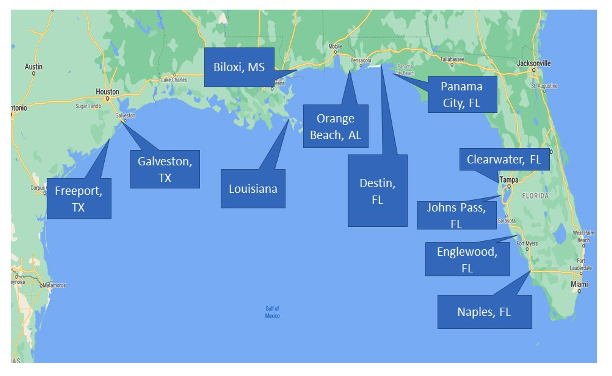
In the first year, Port Ambassadors fielded hundreds of calls and messages and held in-person meetings. Additionally, many Port Ambassadors have held multiple individual one-on-one meetings. In these calls and meetings, the ambassadors explain the mechanics of the ELB program, troubleshoot bugs, glitches and other challenges, highlight the benefits that ELB-use can bring to fishing businesses, and establish greater trust among industry members towards data collection. The Port Ambassadors connect through text thread, small-group meetings, and calls during which we share additional updates and feedback. The Port Ambassadors continue to have ongoing lines of communication with NOAA Fisheries that are used to effectively address challenges and concerns related to ER in the region. Port Ambassadors are recognized as leaders and serve as influential endorsers of the program.
Using Technology
Implementing the program took a significant effort from multiple groups including technology vendors, data groups, NOAA Fisheries, and the industry. The SEFHIER program in the Gulf of Mexico requires electronic submission of data at the completion of a trip and collects various trip details including:
- Trip Declaration: vessel information, trip type, start and end time, estimated end date and time, verified landing location;
- Trip Information: vessel, captain, number of crew and anglers, trip start and end times, landing location, hours fished, fishing location and depth, and fishing method;
- Catch: all fish caught including landings and discards; and
- Economic information: trip fee, fuel used and cost.
Software vendors were able to develop new software to collect the trip reports electronically. To date, both eTrips and VESL software has been released for captains to use to submit their trip reports.
In addition, the Gulf program requires vessel monitoring systems (VMS) to provide location-tracking data and validate trips taken. Early in our discussions, it became clear that traditional VMS would be cost-prohibitive for smaller charter operations and fishermen who are not dually permitted with commercial permits as well. Port Ambassadors worked with both NOAA Fisheries and cellular-based vendors to pilot, troubleshoot, and adapt regulations to allow cellular-based units. The regulatory decisions to permit cellular-based units for location tracking in this program is the first in the nation and provides a much more cost-effective solution for providing location data. Though there are still pockets of resistance to providing location data, our group remains steadfast that location data will help validate our data and it helps those of us who are honest in the industry by cracking down on illegal charters.
Benefits of Port Ambassador Program and ELBs
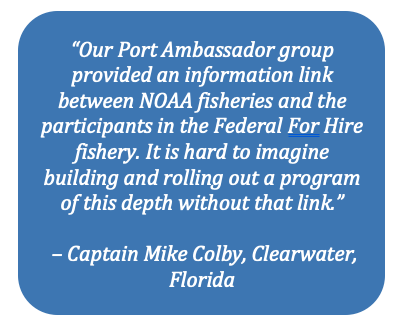
The Port Ambassadors played a uniquely valuable role in the implementation of the ELB program. Without them, implementation could have been much more difficult and public opinion could have been at risk. The electronic reporting will provide industry’s catch and effort data to the agency faster and with greater precision than with MRIP alone. After the data is validated and calibrated with the existing federal data systems, we should see quicker turnaround times for season-length projections and the hope is that our season lengths can be tailored to the needs of our industry. Most importantly, we will be able to fish our season lengths with less probability of exceeding our Annual Catch Limits (ACLs), giving us the chance to have additional days-at-sea while maintaining accountability. Our customers want to be part of a culture that ensures that fish stocks are healthy, so supporting a thriving fishery is part of our goal. We have been able to use the Post Ambassador network as a peer-to-peer influence model to share these benefits throughout the industry and help build support for the many advantages of using ELBs.
Obstacles During Implementation
As with any new regulations, there will be challenges to address as they are implemented. An important role of the Port Ambassadors during the ELB implementation was to serve as a liaison with NOAA Fisheries to make needed improvements to usability for fishermen. One of the biggest challenges we have identified during implementation of the electronic reporting program is addressing potential VMS equipment failure. We are required to submit a declaration of hail-out in advance of leaving the dock; however, if our VMS unit has a failure, it leaves us stranded at the dock with paying clients who we then have to turn away.
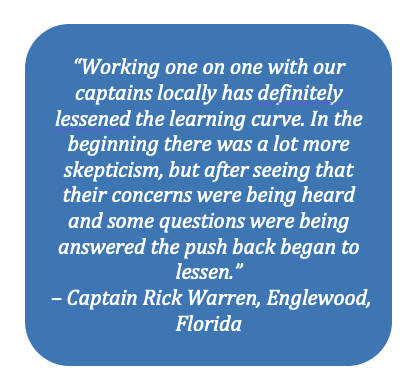
When the final rule document came out, we had covered the software, data metrics being captured, and gotten the hardware approved, however, we all had overlooked this element. It led the Port Ambassadors to support the development of a regulatory framework that defines the process to protect anglers and businesses if down time due to hardware failures occur. Anglers are in town for very small windows of time and being down can disrupt trips planned months in advance. Currently the Gulf Council and NOAA Fisheries are developing and finalizing a rule that will keep anglers on the water, businesses working, and still require trip and harvest data to be turned in to maintain the integrity of the SEFHIER Program.
Anytime you have a new program there will be hurdles and issues to improve. Currently, the Port Ambassadors are heavily focused on usability for fishermen who have issues with hail-out, or trip declarations, and day-to-day functionality. They help smooth implementation and roll-out of new regulatory changes to help get buy-in from fishermen.
Next Steps
Although the ELB program represents a huge step toward better data collection, we hope that this is just one stepping-stone toward more sustainable management for our fisheries. The Port Ambassador program served as a way to share information, helped empower voices in our industry, and gave captains a chance to truly see their impact in their local communities. It would be great to see NOAA Fisheries create a formal peer-to-peer model like this for implementation of other electronic technology implementations. Our hope is that the Port Ambassador program can serve as a model for facilitating the transition from pen-and-paper systems to more effective and efficient electronic reporting systems.
For CFA, the Port Ambassadors program has been an opportunity to strengthen our connections to charter captains across the Gulf and help ensure the sustainability of our fishery for the long-term. But our work isn’t done. We are currently working to test Electronic Monitoring (EM) on a few select boats to see how the addition of video cameras can help improve accountability in our fishery. Bringing our fisheries into the future by using technologies available to us will help us collect and more accurately report data, build our businesses, and sustain them into the future.
Port Ambassador meets with a group of local charter for-hire captains to walk through the ELB program and system requirements. Photo Credit: Bobby Kelly

